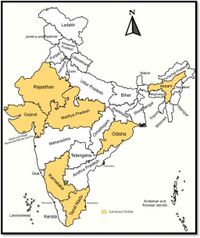Lumpy Skin Disease (LSD) has emerged as a significant threat to the cattle industry in India, causing widespread economic losses during 2022 and 2023. A recent study highlights the staggering impact of this disease, estimating an economic burden of USD 2.44 billion across seven states, including Rajasthan, Gujarat, Tamil Nadu, Karnataka, Madhya Pradesh, Odisha, and Assam. This financial assessment captures not only the direct losses in milk production but also the associated costs related to mortality, treatment, and labor expenses.
The research, which surveyed 2,351 cattle farms, discovered that the median milk loss varied by state, with Rajasthan reporting the highest reduction of 74 liters per animal, followed closely by Gujarat at 90 liters. In comparison, states like Assam and Odisha reported much lower milk losses at 15 and 8 liters, respectively. When observing crossbred cattle specifically, the losses could reach up to USD 237.8 per animal, emphasizing the vulnerability of these cattle to the disease.
The median mortality loss per animal ranged from USD 12.2 to a staggering USD 1,084, indicating the severe consequences faced by farmers whose livestock were infected. During the reported years, around 0.18 million cattle succumbed to LSD in India. These figures challenge the farming community, as the economic repercussions ripple throughout the agricultural sector.
This comprehensive study utilized stochastic modeling, employing Monte Carlo simulations to predict the economic losses due to LSD. The total projected loss due to LSD for the period considered was estimated at USD 2,440.29 million (INR 202,544.07 million), with Rajasthan accounting for the largest share at USD 314.18 million, as stated in the study.
Researchers emphasize that LSD, caused by the lumpy skin disease virus, poses a serious threat not only through direct economic losses but also through its impact on livestock productivity. Effective measures to control the spread of this disease are urgently needed to prevent further financial strain on farmers and ensure the sustainability of the livestock sector in India.
The study indicates that the spread of LSD has been rapid since its emergence in India in 2019. The virus is primarily transmitted through arthropods, contributing to its virulence and spread across states. Farmers often resort to a combination of modern veterinary treatments and traditional remedies to manage their livestock's health, leading to variable treatment costs that further complicate financial assessments.
The researchers collected primary data from 343 farms in Rajasthan, 264 in Gujarat, and others from Tamil Nadu, Karnataka, Madhya Pradesh, Odisha, and Assam, aiming to provide an accurate disaggregated view of the impact of LSD across India’s diverse agricultural landscapes.
The results show clear disparities in how LSD affects different regions. Some states, such as Gujarat, reported higher treatment costs, necessitated by the prevalence of the disease and corresponding agricultural practices. As a result, farmers faced more significant expenses related to both modern medicine and traditional treatment methods.
A breakdown of economic losses revealed that the largest share of the financial burden stems from mortality losses, constituting 42.5% of total costs, followed by modern treatment costs at 26.5% and milk losses at 13.7%. The opportunity cost of labor spent on managing the effects of LSD further added to the farmers’ financial distress.
Researchers assert that to fight the effects of LSD, state governments must intensify vaccination efforts and implement comprehensive biosecurity measures. Currently, vaccination initiatives often occur post-outbreak, which limits their effectiveness in controlling the disease's spread at a regional level.
The study serves as a crucial call for action within India’s livestock sectors, indicating that without effective intervention measures, the adverse economic impacts are likely to escalate, further jeopardizing the livelihoods of rural farmers dependent on cattle for their income.
With a clear emphasis on the urgent need for disease management strategies, this study sheds light on the scale of the economic losses from LSD and underscores the importance of continued research and improved health policies in the livestock sector.
Ultimately, as the incidence of LSD continues to pose a significant threat, reinforcing the infrastructure for disease management will be vital for protecting India’s rich cattle heritage and minimizing future economic losses.

